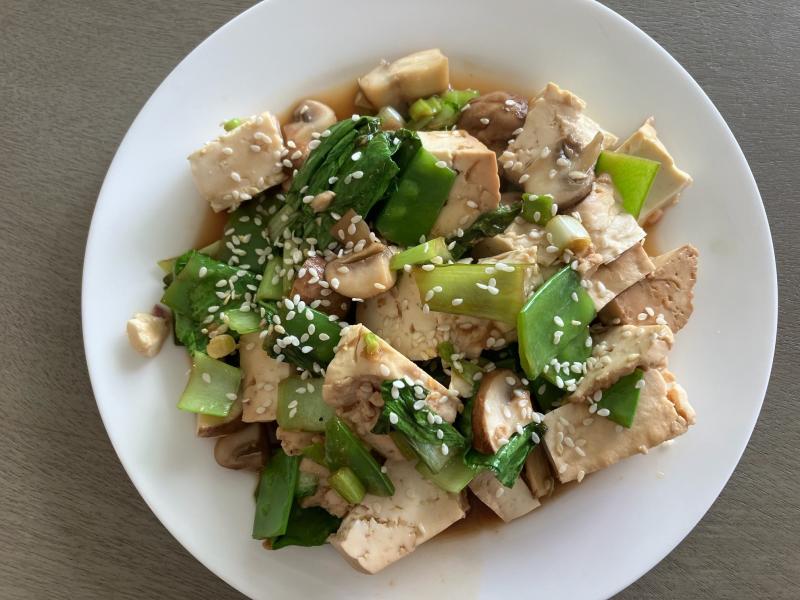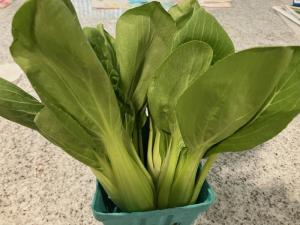Pak choi – an ancient vegetable with many modern uses
The weather was perfect for a visit to the Historic Lewes Farmers Market last Saturday. Most times, I’ll have a list in my head or maybe a few things jotted down, but on my first trip of the season, I just wanted to see what looked interesting. There were lots of asparagus and strawberries, since they’re at the peak of their season, and one of my favorites – pak choi (aka pac choi, pok choi or bok choy).
Sometimes called Chinese cabbage, this vegetable is a member of the botanical family known as brassica, the same genus as mustard and cruciferous vegetables such as broccoli. These were once grouped under the heading of “cole crops,” from the Latin word caulis, for the stem or stalk of a plant, not for the incorrect term “cold crops,” which some thought described the prime season of harvest.
Pak choi is considered to be one of the oldest cultivated vegetables in the world, originating in the Yangtze River Delta of China. By the 14th century, trade routes from the East brought the vegetable to Korea, where it became an ingredient in kimchi. Chinese immigrants to Europe and the United States brought pak choi when they relocated during the 19th century. Today it is widely cultivated around the globe.
Unlike the tightly formed heads of cabbage, pak choi has curved stems topped with oval-shaped leaves that cluster loosely around a bulbous base. The stems vary in color from pale green to white, while the spoon-shaped leaves are darker green. All of the parts are edible, with the stalks slightly fibrous and the leaves crisp. The flavor is a bit tart and mustardy when raw, but it will mellow somewhat when cooked.
While pak choi can be used in a variety of dishes, it is considered a key ingredient on the Chinese New Year celebration menus. It is incorporated whole in some presentations to symbolize wholeness and a prosperous new year, and served in stir-fries or flavorful sauces to represent good luck for the entire family. Either mature bunches or baby stalks of pak choi can be used interchangeably in cooked dishes, but look for the baby bunches for salads.
If you’re at the farmers market tomorrow and see lovely bunches of pak choi, there are a number of ways to prepare it, starting with tossing it into a salad with baby spinach. If you separate the stems from the tender leaves, use the leaves in place of iceberg lettuce on your sandwich. Consider substituting the stems for celery in your chicken salad or crudités platter. Add some green color and nutritional punch to soup with shredded pak choi leaves.
My favorite way to enjoy it is in a simple stir-fry. There are a number of complicated approaches to stir-fry sauces, most of which incorporate a cornstarch slurry as a thickener. I’ve included the stir-fry recipe from Joy of Cooking that I find uses more sauce than vegetables, as well as the recipe I use for the basic (and very fast to assemble) stir-fry seen in the picture. The final recipe is a terrific way to jazz up leftover rice. You can also add some shrimp and shirred egg to extend the simple side dish into a main course.
Stir-Fried Bok Choy*
6 dried shiitake mushrooms
1/2 C boiling water
1 1/2 lbs bok choy
1 T dry sherry
2 t cornstarch
3/4 t white pepper
1 C chicken stock
1/2 t salt
1/2 t sugar
3 T vegetable oil
2 t toasted sesame oil
Place the mushrooms in a bowl and cover with boiling water; allow to hydrate for about 20 minutes. Chop bok choy crosswise into 2-inch pieces; set aside. Remove the mushrooms and chop into 1/4-inch slices. Strain 2 teaspoons of the soaking liquid into a small bowl. Add sherry, cornstarch and pepper; whisk to combine and set aside. In a small bowl, whisk together stock, salt and sugar; set aside. Heat the vegetable oil in a large skillet or wok over high. Add mushrooms and bok choy; cook, stirring often until greens are wilted, about 2 minutes. Stir in the stock mixture, cover and steam for 2 minutes. Add the cornstarch mixture and bring to a boil. Drizzle in sesame oil, stir to combine and serve. Yield: 4 servings. *Adapted from Joy of Cooking.
Stir-fry for One
2 sliced green onions
4 sliced mushrooms
1 bunch pak choi, chopped
3 oz tofu, cubed
1 T olive oil
2 t soy sauce
1 t toasted sesame oil
sesame seeds
Heat the olive oil in a skillet over high. Add green onions and mushrooms; cook until softened. Add pak choi and tofu; cook, stirring often until greens are wilted. Sprinkle with soy sauce; cover and steam for a minute. Remove lid, drizzle with sesame oil and toss to combine. Garnish with sesame seeds. Yield: 1 serving.
Pak Choi Fried Rice
1 minced garlic clove
1/2 t white sesame seeds
1/2 t black sesame seeds
1 T olive oil
1/2 C diced onion
1 diced carrot
1/2 C frozen peas
1 bunch of pak choi, chopped
2 C cold cooked rice
2 T soy sauce
2 t oyster sauce
1/2 t sesame oil
Heat the olive oil in a skillet and gently toast the garlic with the sesame seeds. Add onion, carrot and peas; cook until soft. Add pak choi and cook until wilted. Spread the rice on a plate to separate any clumps, then add to the skillet. Stir in soy sauce and oyster sauce; cook, stirring often until rice is thoroughly heated. Remove from heat and drizzle with toasted sesame oil; stir to combine. Yield: 4 servings.























































